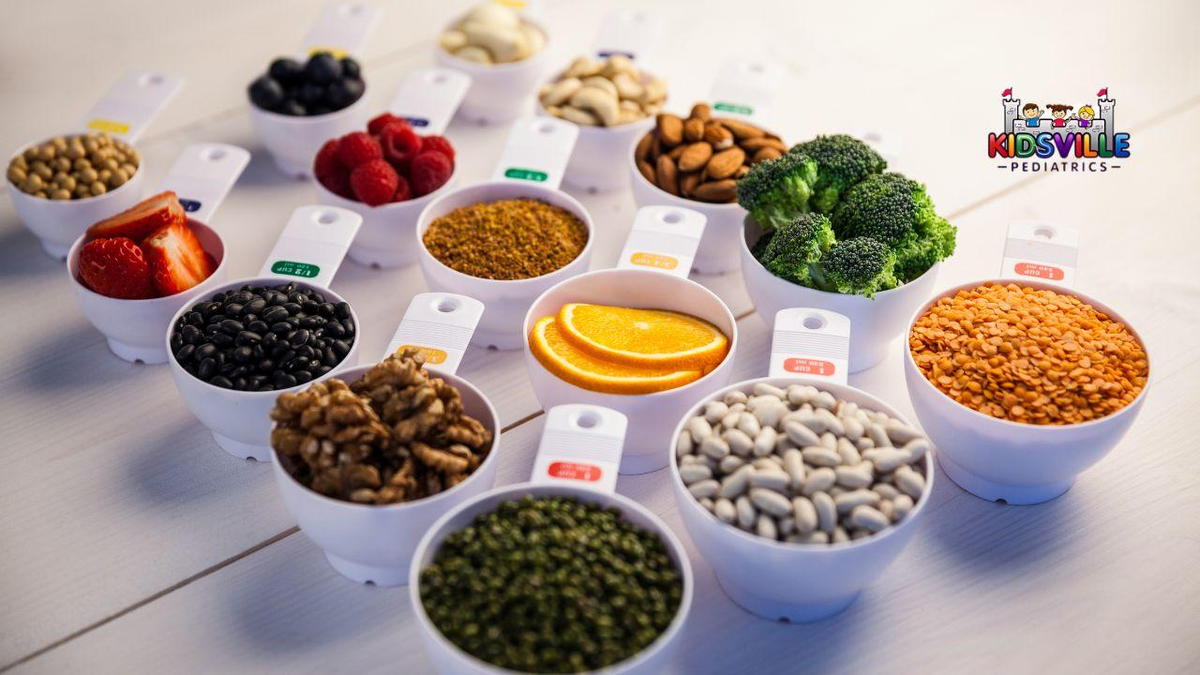
Childhood obesity is a growing concern that impacts the health and well-being of children worldwide. As parents, caregivers, and healthcare professionals, we play a crucial role in addressing this issue and promoting healthier lifestyles for our children. At Kidsville Pediatrics Mansfield TX, we are dedicated to providing comprehensive care and guidance to help families navigate the challenges of childhood obesity.
Understanding the complexities of obesity in childhood is the first step in combating it. This condition can lead to various health issues, including diabetes, cardiovascular diseases, and emotional problems. The good news is that with the right strategies, we can significantly reduce the risk of obesity and improve the overall health of our children. Our goal is to empower parents with the knowledge and tools needed to foster a healthy environment for their kids.
In this article, we will explore ten smart strategies to combat childhood obesity, focusing on practical and effective approaches that can be implemented in everyday life. From nutrition and physical activity to behavioral interventions and medical support, these strategies are designed to address the multifaceted nature of obesity and promote sustainable, healthy habits.
At Kidsville Pediatrics, we believe that early intervention and continuous support are key to preventing and managing childhood obesity. Our team of experienced pediatricians in Mansfield, is committed to working closely with families to develop personalized plans that cater to each child's unique needs. We understand that every child is different, and there is no one-size-fits-all solution. Therefore, our approach is holistic, encompassing various aspects of health and well-being.

1. Balanced Nutrition: Building Healthy Eating Habits
Regardless of your child's age, these strategies can help improve their nutrition and encourage smart eating habits:
Enjoy regular family meals.
Offer a variety of healthy foods and snacks.
Avoid conflicts over food.
Involve children in the food process.
While juggling family schedules and the convenience of fast food can be challenging, our tips in preventing childhood obesity can help you integrate these strategies into your busy household seamlessly.
Family Meals
Family meals provide a comforting routine for both parents and kids. Children appreciate the consistency, and parents have a chance to catch up with their kids. Kids who participate in regular family meals tend to eat more fruits, vegetables, and grains and are less likely to consume unhealthy snacks or engage in risky behaviors. Family meals also allow parents to introduce new foods and model healthy eating habits.
Although teens might initially resist family meals, studies show they still value their parents' advice and guidance. Use mealtime to reconnect with your teens and try these tips:
Let your kids invite friends to dinner.
Involve your children in meal planning and preparation.
Keep mealtime calm and friendly—avoid lectures or arguments.
A family meal can be any time you eat together, whether it's a takeout dinner or a home-cooked meal. Strive for nutritious food and a time when everyone can be present, even if it means adjusting schedules slightly.
Stock Up on Healthy Foods
Children, especially younger ones, are likely to eat what's available at home. Control the supply lines by offering healthy meals and snacks. Follow these guidelines:
Incorporate fruits and vegetables into daily meals, aiming for at least five servings a day.
Make healthy snacks accessible, like fruits, vegetables, low-fat yogurt, peanut butter, and whole-grain crackers.
Serve lean meats and protein sources such as fish, eggs, beans, and nuts.
Choose whole-grain breads and cereals for more fiber.
Limit the family’s consumption of fried foods, instead, choose healthier cooking methods.
Reduce fast food and low-nutrient snacks but don't completely ban favorites—moderation is key.
Limit sugary drinks, preferring water and low-fat milk instead.
Avoid Food Battles
Food should not be a source of conflict. Instead of bargaining or bribing, give kids some control within limits. Let them decide if they're hungry, what to eat from the options provided, and when they're full. Establish a predictable schedule of meals and snacks, and avoid forcing kids to clean their plates. Don't use food as a reward or a way to show love—offer hugs, time, or praise instead.
Get Kids Involved
Involve children in meal decisions and preparations. Discuss choices and plan balanced meals together. Let them help with age-appropriate tasks in the kitchen and teach them to read food labels while shopping. This involvement helps kids learn to make good food choices independently, fostering lifelong healthy eating habits.

2. Understanding Portion Control for Children
Help children understand what appropriate portion sizes look like using visual aids such as measuring cups, food models, or everyday objects. For example, show that a serving of rice is about the size of a baseball and a serving of meat is about the size of a deck of cards.
Use Plates and Bowls
Teach children to use plates and bowls instead of eating directly from the food bag or container. Eating from a plate provides a visual cue that helps them understand appropriate portion sizes.
Teach Hunger and Fullness Cues
Help kids recognize their body's hunger and fullness cues. Coax them to eat slowly and listen to what their bodies are telling them. Teach them to stop eating when they feel comfortably satisfied, rather than when they're overly full.
Encourage Mindful Eating
Teach kids to eat mindfully by paying attention to their food, savoring each bite, and eating without distractions like television or electronic devices. This helps them better recognize when they're full and prevents overeating.
Avoid Using Food as a Reward
Discourage using food as a reward or bribe, as this can lead to an unhealthy relationship with food. Instead, find non-food rewards or incentives to motivate and encourage positive behavior.
Portion Control Tools
Teach portion control tools such as divided plates or portion control containers so you can visually demonstrate the correct serving sizes. These tools help children understand and practice portion control until it becomes a habit.
Talk About Food Labels
As children get older, involve them in reading and understanding food labels. Teach them to look for serving sizes and compare them to what they are actually consuming. Discuss the importance of moderation and making informed choices based on nutritional information.
Ages 2 to 4:
Girls: Calories 1,000 to 1,400, Protein 2 to 4 ounces, Fruits 1 to 1.5 cups, Vegetables 1 to 1.5 cups, Grains 3 to 5 ounces, Dairy 2 to 2.5 cups
Boys: Calories 1,000 to 1,600, Protein 2 to 5 ounces, Fruits 1 to 1.5 cups, Vegetables 1 to 2 cups, Grains 3 to 5 ounces, Dairy 2 to 2.5 cups
Ages 5 to 8:
Girls: Calories 1,200 to 1,800, Protein 3 to 5 ounces, Fruits 1 to 1.5 cups, Vegetables 1.5 to 2.5 cups, Grains 4 to 6 ounces, Dairy 2.5 cups
Boys: Calories 1,200 to 2,000, Protein 3 to 5.5 ounces, Fruits 1 to 2 cups, Vegetables 1.5 to 2.5 cups, Grains 4 to 6 ounces, Dairy 2.5 cups
Ages 9 to 13:
Girls: Calories 1,400 to 2,200, Protein 4 to 6 ounces, Fruits 1.5 to 2 cups, Vegetables 1.5 to 3 cups, Grains 5 to 7 ounces, Dairy 3 cups
Boys: Calories 1,600 to 2,600, Protein 5 to 6.5 ounces, Fruits 1.5 to 2 cups, Vegetables 2 to 3.5 cups, Grains 5 to 9 ounces, Dairy 3 cups
Ages 14 to 18:
Girls: Calories 1,800 to 2,400, Protein 5 to 6.5 ounces, Fruits 1.5 to 2 cups, Vegetables 2.5 to 3 cups, Grains 6 to 8 ounces, Dairy 3 cups
Boys: Calories 2,000 to 3,200, Protein 5.5 to 7 ounces, Fruits 2 to 2.5 cups, Vegetables 2.5 to 4 cups, Grains 6 to 10 ounces, Dairy 3 cups
Be Supportive
Be patient and supportive throughout the process. Encourage your children's efforts, provide positive reinforcement, and offer guidance when needed.
Portion control is not just about what we put on our plates; it's also about the size of the plate, the relative portions of food, and the frequency of refills. Cultivating healthy eating habits includes maintaining regular meal and snack times.

3. Smart Shopping: Reading Nutrition Labels
Understanding how to read a nutrition label is crucial for making healthier food choices for you and your little one. The first thing you should check on a label is the serving information, which tells you the size of a single serving and the total number of servings per container. This data shows the amount people typically eat or drink. Next, look at the total calories per serving and container. Pay attention to the calories contained in one serving and compare this to the number of servings you eat. If you consume two servings, you double the calories and nutrients.
When examining the nutrients section, it's important to limit certain nutrients. Focus on the amount of saturated and trans fats rather than total fats, as not all fats are bad. Avoid trans fat. If the label lists "0 g" of trans fat but includes "partially hydrogenated oil" in the ingredient list, it means the food contains some trans fat, less than 0.5 grams per serving, so eating more than one serving can add up. Total sugars include both natural and added sugars. Limit the amounts of added sugars, saturated fat, and sodium. It's helpful to compare labels on different brands or similar products and choose foods with less of these nutrients when possible.
On the flip side, make sure you get enough of the beneficial nutrients your body needs, such as calcium, dietary fiber, iron, potassium, and vitamin D. Dietary fiber is particularly important as it helps reduce blood cholesterol levels, provides a feeling of fullness, and aids in maintaining a healthy body weight. Adults need at least 25-35 grams of fiber daily for good health.
The % Daily Value (DV) on a label tells you the percentage of each nutrient in a single serving relative to the daily recommended amount. If you want to consume less of a nutrient, such as saturated fat or sodium, choose foods with a lower % DV (5% or less). Conversely, if you want to consume more of a nutrient, like fiber, look for foods with a higher % DV (20% or more). The information on the label is based on a diet of 2,000 calories a day, but your needs may vary depending on age, gender, activity level, and whether you’re trying to lose, gain, or maintain weight.
The U.S. Food and Drug Administration (FDA) is the body that regulates Nutrition Facts labels. In 2016, the FDA updated the label to make it easier to see how many calories and added sugars are in a product and to make serving sizes more realistic. As of January 2020, all food manufacturers were required to implement these changes on their products' Nutrition Facts labels. Understanding these changes and knowing how to read a nutrition label can empower you to make healthier dietary choices for you and your family.

4. The Importance of Regular Physical Activity
Understanding the importance of exercise goes beyond just physical fitness—it impacts every aspect of a child's development. Firstly, regular physical activity plays a pivotal role in building strong muscles and bones, maintaining a healthy weight, and reducing the risk of chronic diseases later in life. Beyond physical health, exercise is a powerful tool for enhancing mental well-being. It uplifts mood, alleviates stress and anxiety, and contributes to overall mental resilience.
Equally important are the social benefits of exercise. Whether playing with friends or family, physical activities foster teamwork, communication, and cooperation—skills essential for navigating the complexities of life. With these foundations in mind, it's clear why incorporating exercise into children's routines is paramount.
Now, let's delve into creative ways to inspire kids to stay active and enjoy it. Transforming exercise into a game—be it a lively scavenger hunt, a spontaneous dance-off, or an inventive backyard obstacle course—makes physical activity enjoyable and engaging. Leading by example is crucial; when children see adults embracing physical activities, they're more likely to participate eagerly.
Variety keeps things exciting, from swimming and biking to hiking and jumping rope, ensuring kids remain enthusiastic about staying active. Setting achievable goals together, whether aiming for a daily step count or mastering a new skill, instills motivation and a sense of accomplishment. Limiting screen time encourages outdoor play, maximizing opportunities for physical activity.
Family involvement is key. Read more about physical activities for children in our article:
Summer Fitness Challenges for Kids
Limit Screen Time, Too
Excessive screen time, coupled with exposure to low-quality content, has also been linked to various issues such as childhood obesity, disrupted sleep patterns, behavioral problems, delayed language and social skills development, and even attention deficits. For young children under the age of 2, unstructured playtime remains crucial for optimal brain development, fostering learning through interaction with caregivers and peers.
As children grow older, some types of screen time, like programs involving music, movement, and storytelling, can be beneficial if monitored and shared with parents or guardians. However, passive screen time should not replace essential activities such as reading, playing, or problem-solving.
Our pediatricians recommend minimal to no media exposure for children under 18 months, and limited, high-quality screen time (no more than one hour per day) for children aged 2 to 5. As children mature, individual needs and interests should inform decisions about screen usage, emphasizing quality over quantity.
To ensure positive screen experiences, parents can take proactive steps. Previewing programs and apps, using interactive options that engage rather than passively entertain, and employing parental controls are effective strategies. Maintaining proximity during screen use allows for supervision and discussions about content, fostering critical thinking and media literacy.
Setting clear boundaries is essential as children grow older. Establishing tech-free zones, encouraging unplugged playtime, and enforcing screen time curfews promote balanced digital habits. Teaching digital literacy and appropriate online behavior prepares children for navigating online spaces responsibly and safely.

5. The Role of Hydration in Preventing Obesity
Amidst the childhood obesity crisis, a recent study has identified a simple yet effective way to help school children maintain healthier weights: ensuring access to clean, readily available drinking water.
The study, conducted across 18 California elementary schools serving predominantly low-income minority families, introduced a "Water First" program. This initiative included installing water stations throughout the schools. Researchers observed significant benefits in terms of children's weight management.
In the nine schools where the Water First program was implemented, the percentage of children classified as overweight remained stable over a 15-month period. In contrast, at schools without the water program, this percentage increased by nearly 4 points.
The approach has a straightforward nature which not only helps prevent weight gain but also promotes cavity prevention and keeps children hydrated for better learning.
The study drew inspiration from middle school students' requests back in 2006 for more drinking water in Los Angeles public schools. At that time, many schools lacked free water, offering only bottled beverages alongside soda and juices. Federal law now mandates free drinking water in school cafeterias during meal times, with sugary drinks banned.
The findings, based on data from northern California elementary schools, underscored a notable difference in overweight prevalence. Schools with the water program saw overweight rates stabilize around 50%, while comparison schools experienced an increase to 51.4%.
While children in the water program schools reduced their intake of sugary drinks based on family food diaries, this effect tapered off after 15 months. However, there was no significant impact on obesity rates, which can be attributed to the challenge of tackling obesity in children with a single intervention.
Despite this, the importance of providing access to clean, appealing water as a fundamental school standard that supports overall health and well-being, was emphasized. This study debunked the myth that children find water unappealing, asserting that children will readily drink plain water when it's readily available.

6. The Impact of Sleep on Weight Management
A sound night's sleep is crucial for good health and may also play a pivotal role in maintaining a healthy weight. Increasing evidence suggests that individuals who consistently sleep insufficiently are at a higher risk of weight gain and adult and childhood obesity compared to those who typically get seven to eight hours of sleep per night. The trend of reduced sleep duration in our society—where the percentage of American adults sleeping eight hours decreased from 35% in 1998 to 26% by 2005—may be a significant factor contributing to the obesity epidemic.
Particularly robust evidence comes from longitudinal studies that tracked sleep habits among large cohorts of children over extended periods, while accounting for various factors that influence obesity risk, such as parental obesity, screen time, and physical activity.
For instance, a British study monitoring over 8,000 children from birth revealed that those sleeping fewer than 10.5 hours per night at age 3 had a 45% higher likelihood of becoming obese by age 7 compared to those sleeping more than 12 hours nightly. Similarly, Project Viva, a prospective study in the U.S. involving 915 children, found that infants averaging fewer than 12 hours of sleep daily had twice the odds of obesity at age 3 compared to those with longer sleep durations. Factors like maternal depression during pregnancy, early introduction of solid foods, and infant TV viewing were associated with shorter sleep durations.
Moreover, childhood sleep patterns may have enduring effects on weight into adulthood. A study in New Zealand monitored 1,037 children from birth to age 32, finding that each hour reduction in childhood sleep correlated with a 50% higher risk of obesity in adulthood.
It's important to note that these studies are observational, meaning they establish associations rather than causation regarding sleep and weight. Definitive answers may emerge from randomized clinical trials currently underway, including one in Australia that examined whether sleep interventions in infants could mitigate obesity risks. Although early outcomes from U.S. trials are promising, larger trials in the U.S. and New Zealand are poised to provide more conclusive evidence on how sleep duration impacts childhood obesity

7. How to Talk to Kids About Healthy Eating Choices
Children tend to adopt healthier eating habits when their parents do. Viewing food as a source of joy and nourishment rather than a foe can significantly enhance their body image and relationship with food.
To broaden the palate of even the most selective eaters, serve the same meals to everyone and encourage children to try new foods multiple times before forming opinions. This approach focuses on creating enjoyable meal experiences rather than pressuring children to finish everything on their plates.
Refrain from negative food-related comments or focusing discussions on weight, as these can lead to negative body image and disordered eating behaviors in children. Instead, promote positive messages around eating real foods, enjoying fruits and vegetables, and listening to hunger and fullness cues without labeling foods as "good" or "bad."
Maintaining a supportive and positive environment around food choices, where children are encouraged to respect others' preferences and try new foods without judgment, can help cultivate healthy relationships with food from an early age.

8. Managing Stress to Prevent Emotional Eating
Emotional eating is eating in response to boredom or other powerful emotions rather than real, physical hunger. It's common among children, teens, and adults alike. Differentiating between emotional eating and genuine hunger involves recognizing key distinctions:
True hunger typically develops gradually due to an empty stomach and can be satisfied by various foods.
Emotional eating, on the other hand, happens suddenly and is seemingly urgent, often triggered by specific events or moods. It often involves cravings for particular foods, such as chocolate after a stressful day.
Signs of emotional eating may include:
Eating in response to emotions rather than hunger
Feeling an urgent need to eat
Craving specific foods
Consuming more food than usual
Eating at unusual times, like late at night
Gaining excess weight
Feeling embarrassed or guilty about eating
Eating in secrecy during stressful times
Emotional eating is associated with a range of emotions and situations, including anger, boredom, stress, and even happiness.
To improve health outcomes, it's crucial to develop healthy responses to emotional eating triggers. This can involve discussing emotions with a friend, family member, or counselor, and finding alternative ways to cope, like going for a walk or calling a friend.
Parents can influence their children's eating behaviors by modeling healthy eating habits and avoiding using food as a reward or comfort. Instead, use positive reinforcement such as verbal praise or non-food rewards like stickers or fun activities.
If you suspect emotional eating in your child, approach the topic gently and positively. Encourage open communication and seek professional help if needed. Emotional eating can lead to physical and emotional health issues, including weight gain and increased risk of conditions like type 2 diabetes and depression.
Pediatric urgent care may be needed and the best pediatrician can provide guidance on distinguishing between emotional and regular eating, addressing occasional emotional eating episodes, managing children's emotional eating habits, and ensuring a balanced approach to nutrition.
9. Best Pediatrician Near Me: Collaboration with Medical Professionals
Helping your children develop healthy eating habits is a journey that may seem daunting at times, but it's far from impossible! At Kidsville Pediatrics Mansfield, we are dedicated to discussing strategies for fostering healthy eating habits in your children. Nutrition plays a crucial role in their development, so it's important not to give up.
The Importance of Nutrition in Child Development
As parents, we understand the critical role nutrition plays at every stage of life, but especially in childhood. Proper nutrition supports their growth and builds a foundation for lifelong healthy habits, which they can pass on to future generations, reducing the risk of diseases.
Benefits of Healthy Eating
Healthy eating habits in children and adolescents are essential for their growth, development, and long-term health. They also help prevent various health conditions that may arise later in life.
What Constitutes a Healthy Diet for Children?
According to the Dietary Guidelines for Americans, a healthy diet for children over two years old should include:
Fruits and vegetables
Protein sources like seafood, lean meat, eggs, and legumes
Whole grains
Dairy products that are low-fat, fat-free, or lactose-free
Healthy oils
Avoiding solid fats, which include saturated and trans fats, is crucial. It's also important to limit sodium intake and avoid added sugars.
Consequences of Inadequate Nutrient Intake
A child who doesn’t receive enough nutrients may experience:
Vitamin and nutrient deficiencies
Weakened immune system
Increased susceptibility to common childhood illnesses
How Your Pediatrician Supports Healthy Eating
At Kidsville Pediatrics Mansfield, our pediatricians specialize in guiding you on the best foods and vitamins for your child's health. They also recommend lifestyle practices that contribute to your child's overall well-being.
Proper Food Intake
Regardless of age, consuming nutrient-rich foods and beverages is vital. According to the USDA, children should consume the following daily calories for optimal growth:
Ages 2-3: 1,000 calories (both genders)
Ages 4-8: 1,200-1,400 calories (girls) / 1,200-1,600 calories (boys)
Ages 9-13: 1,400-1,600 calories (girls) / 1,600-2,000 calories (boys)
Ages 14-18: 1,800 calories (girls) / 2,000-2,400 calories (boys)
It's crucial never to skip breakfast, as it provides essential energy for the day and helps reduce the risk of childhood obesity.
Foods Your Children Should Avoid
To maintain a healthy diet, it's best for your child to avoid foods high in:
Refined grains
Added sugars
Saturated fats (such as lard, butter, and margarine)
Solid fats
Processed foods (like pizza, chips, and crackers)
Sugary foods and drinks (including cookies, cake, and soft drinks)
While it may be challenging for your child to avoid these foods entirely, moderation is key.
7 Tips for Addressing Picky Eating
Dealing with picky eaters is a common challenge for parents. Remember, it's a normal phase for toddlers. Here are some tips to help you navigate picky eating without turning mealtimes into a battle:
Set a good example by practicing healthy eating habits yourself.
Avoid food conflicts and respect your child's appetite.
Add spices and herbs to enhance the flavor of healthy dishes.
Involve your kid in preparing meals and buying food.
Gradually introduce new foods and flavors.
Pair liked and disliked foods to encourage balanced eating.
Avoid using bribes or punishments related to food.
Establishing Lifelong Healthy Eating Habits
Instilling healthy eating habits during childhood promotes lifelong health and reduces the risk of diseases like heart disease, type 2 diabetes, and obesity in children. It also sets a positive example for future generations.
Remember, healthy eating starts at home. By modeling healthy eating behaviors and providing nutritious meals, you teach your child the importance of making good food choices.

10. Monitoring Your Child's Healthy Eating Journey
Typically, parents are responsible for overseeing their child's food choices, while the child is usually better at gauging how much food they need. Normally, healthy and active children's bodies intuitively regulate their food intake quite well, although their food preferences may sometimes lead them astray.
Occasional weighing of children is one method parents can use to monitor their nutrition. Counting calories for children is seldom necessary, as most children naturally regulate their intake effectively. As children progress through middle childhood, their overall energy needs increase, leading to higher food consumption, especially approaching puberty. From ages seven to ten, both boys and girls typically consume between 1,600 to 2,400 calories daily, though individual needs vary considerably even under normal circumstances.
Girls often experience a notable growth spurt between ages ten and twelve, increasing their daily caloric intake by about 200 calories, while boys undergo their growth spurt about two years later, increasing their food intake by nearly 500 calories daily. During these rapid growth phases, their overall calorie and nutrient requirements, from calcium for bone growth to protein for tissue development, are likely higher than at any other life stage.
Boys generally require more calories than girls across most ages due to their larger body size, though appetites can fluctuate day to day based on factors such as activity levels. For example, a child who spends an afternoon on homework might require fewer calories than one engaged in outdoor play after school. Each child's calorie needs are unique and can vary widely.
It's common to overestimate a child's food requirements, especially during the early years of middle childhood. Children at this stage do not need portions as large as those for adults. If this is overlooked, parents might serve nearly as much food to their child as they would eat themselves. This situation forces the child to decide between leaving food uneaten, risking criticism, or overeating and potentially facing obesity in children.
DisclaimerThis article provides general information and discussions about health and childhood obesity. The content provided is not intended and should not be used as a substitute for actual medical advice, diagnosis, or treatment. Kindly contact your pediatrician in Mansfield before starting a new health regimen for your kid. Visit also our other locations in Southlake and McKinney: Kidsville Pediatrics Mansfield TX: 682-341-3910; 1759 Broad Park Circle S, Suite 201 & 205, Mansfield, TX Kidsville Pediatrics Southlake: 682-345-8010; 2813 W. Southlake Blvd Suite 100 Southlake, TX Kidsville Pediatrics McKinney: 469-885-9400; 5881 Virginia Pkwy. Suite 300 Mckinney, TX |